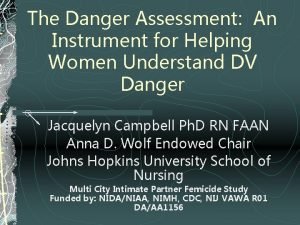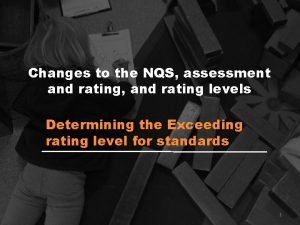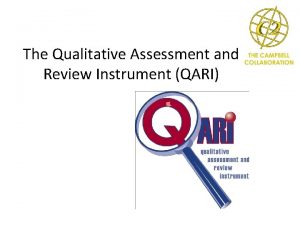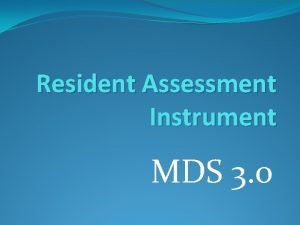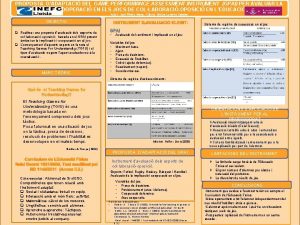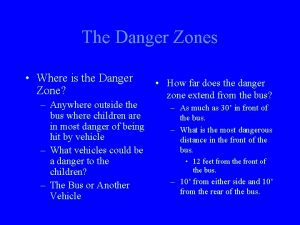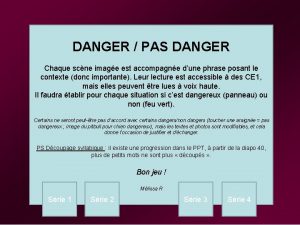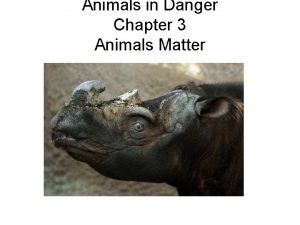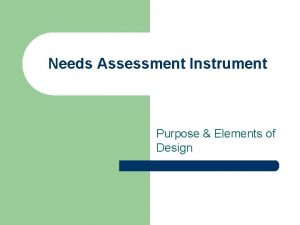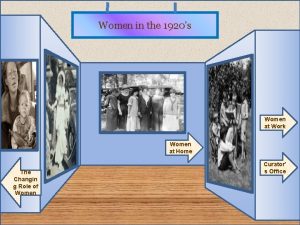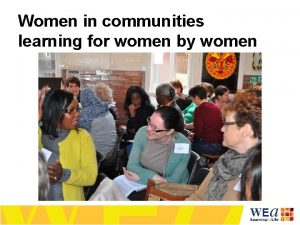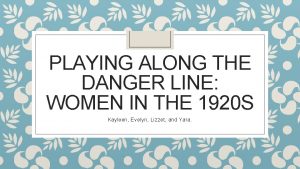The Danger Assessment An Instrument for Helping Women



































































- Slides: 67

The Danger Assessment: An Instrument for Helping Women Understand DV Danger Jacquelyn Campbell Ph. D RN FAAN Anna D. Wolf Endowed Chair Johns Hopkins University School of Nursing Multi City Intimate Partner Femicide Study Funded by: NIDA/NIAA, NIMH, CDC, NIJ VAWA R 01 DA/AA 1156

DANGER ASSESSMENT (Campbell ‘ 86) www. dangerassessment. org Developed in 1985 to increase battered women’s ability to take care of themselves (Self Care Agency; Orem ‘ 81, 92) – original DA used with 10 samples of 2251 battered women to establish preliminary reliability & validity Interactive, uses calendar - aids recall plus women come to own conclusions - more persuasive & in adult learner/ strong woman/ survivor model Intended as lethality risk instrument versus reassault (e. g. SARA, K-SID) - risk factors may

Independent Predictive Validity Studies - Reassault (Goodman, Dutton & Bennett, 2001) N = 92; 53% returned; successful prediction of reabuse, DA stronger predictor than CTS 2 (4. 2 vs. 2. 8 OR per 1 SD DA vs. CTS 2) Women’s perception of danger stronger predictor than any of the 10 DA items available in criminal justice records – (Weisz, Tolman, & Saunders, 2000) Heckert & Gondolf (’ 02; ‘ 04) N = 499 – DA- 66% sensitivity but 33% false positives - Women’s perception of risk PLUS DA best model (over SARA & K-SID) but women’s perception of risk by itself not quite as good as DA

Femicide Risk Study Purpose: Identify and establish risk factors for IP femicide – (over and above domestic violence) Significance: Determine strategies to prevent IP femicide – especially amongst battered women – Approximately half of victims (54% of actual femicides; 45% of attempteds) did not accurately perceive their risk – that perpetrator was capable of killing her &/or would kill her

RISK FACTORS FOR INTIMATE PARTNER FEMICIDE: RESEARCH TEAM (Funded by: NIDA/NIAA, NIMH, CDC, NIJ VAWA R 01 DA/AA 1156) R. Block, Ph. D (ICJA) D. Campbell, Ph. D, RN (FSU) J. Mc. Farlane, Dr. PH, RN (TWU) C. Sachs MD, MPH (UCLA) P. Sharps, Ph. D, RN (GWU) Y. Ulrich, Ph. D, RN (UW) S. Wilt, Ph. D (NYC DOH) F. Gary, Ph. D, RN (UFl) M. A. Curry Ph. D, RN (OHSU) N. Glass, Ph. D, RN (OHSU) J. Koziol-Mc. Lain, Ph. D, RN (JHU) J. Schollenberger MPH (JHU) A. Kellerman, MD, MPH (Emory) X. Xu, MSN (JHU) Kathryn Chouaf, MSN (JHU)

RISK FACTORS FOR INTIMATE PARTNER FEMICIDE: CITIES AND CO-INVESTIGATORS (Funded by: NIDA/NIAA, NIMH, CDC, NIJ VAWA R 01 DA/AA 1156) Baltimore Chicago Houston Kansas City, KA&MO Los Angelos New York Portland, OR Seattle, WA Tampa/St. Pete Wichita, KA P. Sharps (GWU) B. Block (ICJA) J. Mc. Farlane (TWU) Y. Ulrich (UW) C. Sachs (UCLA) S. Wilt (NYDOH) M. A. Curry (OHSU) Y. Ulrich (UW) D. Campbell (FSU) Y. Ulrich (UW)

RISK FACTORS FOR INTIMATE PARTNER FEMICIDE: 11 CITIES (Funded by: NIDA/NIAAA, NIMH, CDC, NIJ VAWA R 01 DA/AA 1156)

Case Control Design Data Source CASES - women who are killed by their intimate partners CONTROLS - women who are physically abused by their intimate partners (second set of nonabused controls – for Police Homicide Files Proxy informants Women themselves

Addition of Attempted Femicides Data Source CASES - women who are killed by their intimate partners CONTROLS - women Police Homicide files Proxy informants Women themselves who are physically abused by their intimate partners CASES - women who Women are ALMOST killed by themselves – to

Definition: Attempted Femicide GSW or SW to the head, neck or torso. Strangulation or near drowning with loss of consciousness. Severe injuries inflicted that easily could have led to death. GSW or SW to other body part with unambiguous intent to kill. If none of above, unambiguous intent to kill.

Recruitment of Attempted Femicides From police assault files – difficult to impossible in many jurisdictions From shelters, trauma hospital data bases, DA offices – attempted to contact consecutive cases wherever located – many victims move Failure to locate rates high – but refusals low (less than 10%) Telephone interviews – subsample of 30 in depth Safety protocols carefully followed

In Depth Interviews (N = 30) (Nicolaidis et. al. 2003, J of General Internal Medicine) Interviews conducted on phone or anywhere woman wished Baltimore, Houston, Kansas City, Portland, Tampa, & Wichita – approximately 15% from each city Age 17 -34 – 40% African American, 40% Anglo, 20% Hispanic; across income categories 10 (67%) had history of escalating physical &/or sexual assault; 5 (17%) with minor violence and controlling behavior, 2 with controlling behavior

In Depth Interviews (N = 30) Even so, 14 women (almost half) said they had NO clue how dangerous he was – but with DA, all but 3 could have been identified 73% of cases – significant relationship change – majority – she was leaving him but in 4 cases he had left her but got enraged when she started seeing someone else or wouldn’t take him back when he changed his mind About 30% – clearly at risk – she was scared & we would have been scared for her – about 55% could have been identified with skilled risk assessment – but 15% almost totally out of the

PRIOR PHYSICAL ABUSE & STALKING EXPERIENCED ONR YEAR PRIOR TO FEMICIDE (N=311) & ATTEMPTED FEMICIDE (N=182) Prior physical abuse Increased in frequency Increased in severity Stalked No prior physical abuse Stalked Femicide Attempted 70% 66% 62% 87% 72% 54% 60% 95% 30% 58% 28% 72%

INTIMATE PARTNER ABUSED CONTROLS (N = 356) Random sample selected from same cities as femicide and attempted femicide cases Telephone survey conducted 11/98 - 9/99 using random digit dialing Women in household 18 -50 years old & most recently celebrated a birthday Women abused (including sexual assault & threats) by an intimate partner w/in 2 years prior – modified CTS Safety protocols followed

Sample – (only those cases with prior physical abuse or threats) FEMICIDE CASES Number 220 ATTEMPTED FEMICIDE CASES 143 ABUSED CONTROLS 356

Sociodemographic comparisons Mean Age Fem/Att Perp = 36 Abuse Perp = 31 Fem/Att Victim = 34 Abuse Victim = 29

DANGER ASSESSMENT - Actual (N = 263) & (N=342)* Attempted (N=182) Femicides & Abuse Victims Reliability (Coefficient Alpha) - Attempted Femicide Victims - Abused Control Victims - Actual Femicides . 75. 74. 80 * Presence of DA items within one year prior to femicide and attempted femicide and within one year prior to worst incident of physical abuse experienced by abused controls

DANGER ASSESSMENT SCORES Mean SD Abused Controls 2. 9* 2. 8 Attempted Femicide 7. 9 3. 2 All Femicides 7. 1 3. 4 Femicide w/o 7. 0 3. 6 suicide 7. 4 3. 2 Femicide/suicide Attempted and Femicide scores significantly higher than abused controls (*p<. 05)

DANGER ASSESSMENT ITEMS COMPARING ACTUAL & ATTEMPTED FEMICIDE SURVIVORS (N=493) & ABUSED (WITHIN PAST 24 MONTHS) CONTROLS (N=427) (*p <. 05) Att/Actual Control Physical violence increased in frequency* Physical violence increased in severity * Partner tried to choke victim * A gun is present in the house * Partner forced victim to have sex * Partner used street drugs * Partner threatened to kill victim * Victim believes partner is capable of killing her * Perpetrator AD Military History (ns. ) Stalking score* 56% 62% 50% 64% 39% 55% 57% 54% 16% 4. 6 24% 18% 10% 16% 12% 23% 14% 22% 2. 4

VICTIM & PERPETRATOR OWNERSHIP OF WEAPON IN FEMICIDE (N = 311), ATTEMPTED FEMICIDE (N = 182), ABUSED CONTROL (N=427) & NON-ABUSED CONTROL (N=418) CASES 2=125. 6, P<. 0001

Arrest, Protective Orders & Weapon Use 48 (33. 6% of 156) of attempteds were shot 15 of the 45 (33. 3%) with data - perpetrator either had prior DV arrest or PO at the time of the incident 91 of 159 (57. 3%) femicides that had weapon information were shot Of 74 with data, 27 (36. 5%) had a prior DV arrest or had a restraining order at the time of the incident According to federal legislation – these

DANGER ASSESSMENT ITEMS COMPARING ACTUAL & ATTEMPTED FEMICIDE SURVIVORS (N=493) & ABUSED (WITHIN PAST 24 MONTHS) Partner is drunk every day * CONTROLS (N=427) (*p <. 05) Partner controls all victim’s activities * Att/Actual Control Partner beat victim while pregnant * Partner is violently jealous of victim (says things like “If I can’t have you, no one can”)* Victim threatened/tried to commit suicide Partner threatened/tried to commit suicide * Partner is violent toward victim’s children* Partner is violent outside house* Partner arrested for DV* (not criminality) 42% 60% 36% 79% 7% 39% 9% 49% 27% 10. 1% 12% 32% 7. 7% 32% 9% 19% 3% 38% 15% 8. 5%

Nonsignificant Variables of note Hurting a pet on purpose -10% of attempteds/actual victims vs. 8. 5% of controls BUT – some clear cases of using cruelty to a pet as a threat to kill WAS a risk for women to be abused (compared with nonabused controls) (AOR = 7. 59 – Walton-Moss et al ’ 05) AND more (but still not sign. ) risk in attempted femicide sample – perhaps proxies not as knowledgeable about pets – warrants further investigation Perpetrator military history – 16%

Risk Models Femicides with abuse history only (violence & threats) compared to abused controls (*N=181 femicides; 319 abused controls – total = 500 (18 -50 yo only) Missing variables had to be excluded from femicide model due to missing responses – if don’t know – no – therefore underestimate risk Logistic Regression Plan – comparing cases & controls Model variable in blocks – background characteristics – individual & couple, general violence related variables, violent relationship

Significant (p<. 05) Variables (Entered into Blocks) before Incident (overall fit = 85% correct classification) Perpetrator unemployed OR = 4. 4 Perpetrator gun access OR = 5. 4 Perpetrator Stepchild OR = 2. 4 Couple Never Lived Together OR = . 34 Highly controlling perpetrator OR = 2. 1 Estranged X Low control (interaction) OR = 3. 6 Estranged X Control (interaction) OR = 5. 5 Threatened to kill her OR = 3. 2 Threatened w/weapon prior OR = 3. 8 Forced sex OR = 1. 9

Significant (p<. 05) Variables at Incident Level Perpetrator unemployed OR = 4. 4 Perpetrator Stepchild OR = 2. 4 Couple Never Lived Together OR = . 31 Threatened w/weapon prior OR = 4. 1 Highly controlling perpetrator OR = 2. 4 Estranged X Low control (interaction) OR = 3. 1 Estranged X Control (interaction) OR =

(32% of femicide cases in study – 29% US) Significant explanatory power for same femicide – suicide risk factors. Partner access to gun Threats with a weapon Step child in the home Estrangement Unique to femicide – suicide: Partner suicide threats – history of poor mental health Married Somewhat higher education levels (unemployment still a risk factor), more likely to

CONCLUSIONS ALL DV IS DANGEROUS But 10 or more yeses on revised scale very dangerous Much more sensitive & specific if weighted items used – ROC curves – area under curve. 91 (vs. 88 &. 83 original version) with acceptable PPV at identifiable higher and lower danger ranges

Instructions for Scoring Revised Danger Assessment Add total number of “yes” responses: 1 through 19. _____ Add 4 points for a “yes” to question 2. _____ Add 3 points for each “yes” to questions 3 & 4. _____ Add 2 points for each “yes” to questions 5, 6, & 7 _____ Add 1 point for each “yes” to questions 8 & 9. _____ Subtract 3 points if 3 a is checked. _____

Danger Assessment Certification _________________________________ has completed the Danger Assessment Training Program and is certified to use the Danger Assessment and Levels of Danger Scoring System to evaluate the level of danger in domestic violence cases. Jacquelyn C Campbell, Ph. D, RN, FAAN Anna D Wolf Chair Associate Dean for Faculty Affairs The Johns Hopkins University School of Nursing Date NAME OF VICTIM: Danger Assessment Scoring Revised 2004 Add total number of “Yes” responses, 1 through 19. Add 4 points for a “Yes” to question 2 Add 3 points for each “Yes” to questions 3 and 4. Add 2 points for each “Yes” to questions 5, 6 and 7. Add 1 point for each “Yes” to questions 8 & 9 Subtract 3 points if 3 a is checked Levels of Danger Less than 8 Variable Danger 8 – 13 14 -17 18 or more Increased Danger Severe Danger Extreme Danger TOTAL Use of this Danger Assessment Scoring system is restricted to ______________ Danger Assessment Certified xx/xx/2005

Cutoff Ranges - VISE Based on sum of weighted scoring place into 1 of the following categories: Less than 8 - “variable danger” 8 to 13 - “increased danger” 14 to 17 - “severe danger” 18 or more - “extreme danger”

Tentative suggestions for ranges NEVER DENY SERVICES ON BASIS OF DA or ANY OTHER RISK ASSESSMENT AT CURRENT STATE OF KNOWLEDGE Variable danger range – be sure to tell women level can change quickly – watch for other signs of danger, believe their gut Increased and severe danger – advise women of risk, assertive safety planning; consult with judges, high level of supervision recommendations Highest level – advise of serious danger – take assertive actions – call for criminal justice or other professional help -- recommend highest

Risk Prediction 4 Quadrant Model (Webster et. al. ‘ 94) Combination of Sensitivity & Specificity = ROC Curve (Receiver Operating Curve)

the curve for Attempted Femicides; 90% for actuals

Comparisons on Cutoffs – Sensitivity/Specificity Femicide Attempt s eds Specific ity Variable Danger < 8 90% 92% 69% Increased Danger: 8 – 13 Severe Danger: 14 – 17 Extreme Danger: 18 + 86% 90% 70% 83% 86% 80% 57% 48% 98%

Revised DA Scores (ANOVA p<. 000) Group Not abused N Mean 407 -1. 54 Abused Controls 328 SD 2. 35 2. 80 5. 61 Attempted 108 14. 87 Femicides Actual Femicides 132 15. 20 7. 28 7. 20

Praxis Danger Assessment - support for validity large US case control study DA as important basis for safety planning - use of cutoffs with caution Revised with femicide data – wording checked with victims & advocates across programs – shelter & health care system – PA Ranges determined – & tested with attempted femicides Wording of levels of danger tested with women Computerized scoring testing now

Implications for Policy & Safety Planning Engage women’s mothering concerns & skills (Henderson & Erikson ’ 97 ‘ 93; Humphreys ‘ 93; Sullivan et. al. ‘ 00) If she says she’s going to leave, cannot leave face to face Importance of forced sex & stepchild variables – not on most risk assessment instruments Make sure she knows entire range of shelter services Be alert for depressed/suicidal batterer

Alberta Council of Women’s Shelters DA Collaborative All women in shelter – 1 st & 2 nd Stage – in province of Alberta complete DA with advocate within first 48 -72 hours of shelter admission All advocates certified in DA – Train the trainer (shelter directors) model so new advocates trained § Research funded by Community Incentive Fund, Government of

Alberta Council of Women’s Shelters DA Collaborative – 9 shelters Emergency shelter – 6 (N = 209) Second stage shelters 3 (N = 26) Two on reserve (emergency) shelters 66% married or common-law Average = 30. 69 33% English Canadian; 6% other visible minority; 51% Aboriginal self-identify -

Alberta Council of Women’s Shelters DA Collaborative – 9 shelters Project Data (‘ 07 -’ 08): 235 participants 198 calendars completed Spiritual, emotional, financial abuse as well as physical 180 qualitative responses 4 focus groups Shelter staff survey

Type of Abuse Experienced – Physical Severity 1 -5 – on DA Calendar

ACWS Outcomes Pre Post DA

Outcome results on 4 key questions (outcomes not significantly different for aboriginal women)

Alberta Council of Women’s Shelters DA project: Preliminary Analysis of Qualitative Data – Major themes : v Hard to do v “It’s terrible to look back on!” v “-very stressed –all the emotional stuff came back – feeling low” v “Had to hold back tears. ” “It hurts. ” v Increased Awareness – decrease minimization v “Confusing and clarifying because at first impression I minimize, then realize the truth!” v “It was eye opening. I have spent a lot of time trying to minimize my experiences so I could be

Alberta Council of Women’s Shelters DA project: Preliminary Analysis of Qualitative Data – Major themes : v Healing experience v “It was painful when I was thinking [about] all the abuse but it helps me as well to loosen my breathing. ” v “It felt good to get it off my shoulders. ” v Realization of danger v “It was shocking to realize that you are in a terrible situation and you don’t even realize it. ” v “It helped me to know how much danger I

Alberta Council of Women’s Shelters DA project: Preliminary Analysis of Qualitative Data – Major themes : v Strengthening Resolve v “I should try more to seek outside help to prevent any abuse” v “made me stronger in supporting my decision to be free of stress and harm, especially for my baby…. stay safe and secure always, not letting my guard down” v “Well, I want to be able to see my daughter grow. I want her to be able to be a little girl. I don’t want to keep the cycle going. I want her to see good things while she grows up

Intimate Violence Risk Assessment Validation Study – J. Campbell, C. O’Sullivan & J. Roehl – NIJ #2000 WTVX 0011 N = 782 women who had accessed system through calling police, civil court, shelter or hospital ED’s – NY & CA (LA County) Relatively severely abused – 43% severe abusive tactic from CTS last 6 mos 60% retention from Time 1 – more severely abused. employed & Latina less like to return 38% foreign born; 28% African American; 48% Hispanic/Latina

As important as the “instrument or system” – the protocol – Elements Needed: Agreement on purpose of risk assessment in system Approach to victims if involved What is said to encourage participation What is said regarding use of results – confidentiality If perpetrator – what are legalities of use of results Who conducts the risk assessment – first responders? In depth assessors?

Protocol - continued What happens to results What is communicated to victim What is communicated to system – what parts and for what use Where is paperwork stored – who has access How can victim access later?

Washington Post 10/2/07 http: //www. mnadv. org/lethality. ht ml Under leadership of Dave Sargent – sargent 47@msn. com – (retired DC officer) & Maryland Domestic Violence Network Coalition – researchers, criminal justice, advocates - identified need for risk assessment for first responders Identified need for quick lethality risk assessment (vs. re-assault) Based on research (modification of DA) & practitioner/first responder wisdom – identified 10

Maryland Process Continued Protocol developed – any of first 3 items (or 3 of next 8) Victim told of high risk Told first line of defense is advocacy network – told about options available there – full range of services Urged to call DV shelter hotline – officer dials She can talk but does not have to – officer gives case specifics if she does not want to talk – questions & safety planning advice given She is given one last opportunity to talk to

Maryland Protocol – top 3 Has he/she threatened to kill you or your children? Has he/she used a weapon against you or threatened you with a weapon? Do you think he/she might try to kill you? Yes to any one screens in

Maryland Protocol – any 3 additional triggers protocol Does he/she have a gun or can get one easily? Has he/she ever tried to choke you Is he/she violently jealous or control most or all of your daily activities? Have you left him or separated after living together or being married in the past year? Is he/she unemployed? Has he/she threatened or tried to kill self? Do you have a child that he/she knows is not his/hers? Does he/she follow or spy on you or leave threatening messages? Is there anything else that worries you about your safety? – assessor judgment about response

Maryland Pilot 142 Screens completed in 1 month – 3 jurisdictions 85 victims (62% of the 142 screens) "screened in" 52 (62% of the 85 positive screens) spoke with a counselor 2 (of 3 top 3) factors with highest number of positive responses l l Severe jealousy and controlling factor (77 yeses out of 142) Strangulation (choking) factor (73 out of 142). Screens not problematic to administer - 95% of officer screens were understandable according to victims & to officers administering the Screens 82% of officers said the Screen was "very easy" to "fairly easy" to administer Screens very consistent with full DA - 89% at Severe. Extreme In depth interviews - consensus among

Maryland Process Several meetings and emails for agreement on process Training for first responders and advocacy system Training video developed Pilot roll out 8 -9/04

Maryland Network Lethality Assessment Full rollout – 2006 – 60 jurisdictions (now 157 more) Outcomes – in 06 - almost one in three (284) of the 900 women who talked to a DV Advocate on the scene later showed up at a domestic violence services agency -- for a protective order, shelter, counseling, support group or other service. On the Eastern Shore 90% of 354 victims had not received domestic violence services in the past (86% of high risk had never before sought help) But 60% of those told that high risk talked to an advocate at the scene

(YTD) 63 Agencies and 14 Programs Reporting Period/ Lethalit LS/D # y ay Jurisdic Screens tions Positive Negati ve DNA Spoke to Advocate Went for Service s 3 Qtrs. ‘ 08 (63) 4, 696 17. 1 2, 697 (57%) 1, 722 (37%) 277 (06 %) 1, 557 (58%) 5. 7/day 433(28 %) 1. 6/day 2007 3, 304 9. 1 1, 923 (58%) 1, 179 (36%) 202 (06 %) 1, 030 (54%) 2. 8/day 263 (26%) 0. 7/day 2006 1, 839 5. 0 990 (54%) 698 (38%) 151 (08 %) 531 (54%) 1. 4/day 158 (30%) 0. 4/day Totals - 9, 839 33 mos 9. 8 5, 610 (57%) 3, 599 (37%) 630 (06 %) 3, 118 (56%) 854 (27%) (43) (21) (63

The “Big” Picture Putting your findings within state & federal systems – mortality statistics, maternal mortality, child fatality reviews, SHR, suicide reviews Count yearly – hand counts from localities – at least big cities – at least females Policy recommendations – audiences Community education - media? – educating – having them call fatality reviews first! State and local legislation – collaboration with state DV coalition/network Local policies – e. g. gun removal

Ideal Process Model Offenders in CJ or BIP Or MH or SA Tx MD Lethality Assessment or B-SAFER Women in Shelters Or Health Care System Risk Assessment Partners of Men in System Danger Assessment & Safety Assessment Judicial System Safety Audit – Including Fatality Reviews

Advice for Fatality Review Teams Interview a member of the family of the victim – who she/he confided in – interview by a member of team or staff (Baltimore Fatality Review Team has a interview protocol – will share) Otherwise will never know which cases had prior DV Get information from CPS about all children but also victim & perpetrator as children – also child witnesses Attempted homicides if possible Get health care records – victim & perpetrator HIPAA can be waived (Baltimore has model letter that can share) From local ED’s, urgent care Local hospitals – inpatient and outpatient – physical & mental health, prenatal care or at least birth records

Implications for Policy – System Issues Making sure he doesn’t have access to her as part of the court process Importance of forced sex, stepchild & choking variables – not on most risk assessment instruments Issues with marital rape prosecution l Strangulation issues l Blended families l Make sure she knows entire range of shelter services Be alert for depressed/suicidal batterer

Policy/Practice/Research - System Implications Need for substance abuse Tx in abusive men – concurrent with batterer intervention? Combination programs? New models needed with rigorous evaluations Coordinated community response with probation, courts, batterer intervention and DV victim services closely working together Need for collaborations btw. researchers & clinicians in substance abuse, health, criminal justice and advocacy – for advances in risk assessment – research and policy

Future Directions “Danger Assessment is a Process not a Product” (B. Hart) Field developing rapidly – watch literature Differentiating lethality & reoffending risk - different batterer typologies may explain differences (Holtzworth-Munroe) Strategies for working with victims important – to increase their realistic appraisal and to determine risk factors not available from criminal record checks or from perpetrators never previously arrested – e. g. as part of batterer intervention programs Assessing safety – protective strategies as well as danger – implications for interventions Two parallel processes – reoffending risk for

Immigration Issues May pretend that understands English better than she/he does Language as a means of control Telephone interpreter better than nothing but best to have a member of team – Afraid of deportation May have been threatened with own deportation OR a family member’s deportation

Never forget who it’s for “please don’t let her death be for nothing – please get her story told” (one of the Moms)
 23 helping verbs song
23 helping verbs song Ms risk factors
Ms risk factors Null type instruments
Null type instruments Nqs assessment
Nqs assessment Qualitative assessment and review instrument
Qualitative assessment and review instrument Game performance assessment instrument
Game performance assessment instrument Resident assessment instrument definition
Resident assessment instrument definition Game performance assessment instrument
Game performance assessment instrument Fspos vägledning för kontinuitetshantering
Fspos vägledning för kontinuitetshantering Typiska novell drag
Typiska novell drag Nationell inriktning för artificiell intelligens
Nationell inriktning för artificiell intelligens Ekologiskt fotavtryck
Ekologiskt fotavtryck Varför kallas perioden 1918-1939 för mellankrigstiden?
Varför kallas perioden 1918-1939 för mellankrigstiden? En lathund för arbete med kontinuitetshantering
En lathund för arbete med kontinuitetshantering Kassaregister ideell förening
Kassaregister ideell förening Tidbok
Tidbok Anatomi organ reproduksi
Anatomi organ reproduksi Vad är densitet
Vad är densitet Datorkunskap för nybörjare
Datorkunskap för nybörjare Stig kerman
Stig kerman Debatt artikel mall
Debatt artikel mall Autokratiskt ledarskap
Autokratiskt ledarskap Nyckelkompetenser för livslångt lärande
Nyckelkompetenser för livslångt lärande Påbyggnader för flakfordon
Påbyggnader för flakfordon Arkimedes princip formel
Arkimedes princip formel Offentlig förvaltning
Offentlig förvaltning Lyckans minut erik lindorm analys
Lyckans minut erik lindorm analys Presentera för publik crossboss
Presentera för publik crossboss Jiddisch
Jiddisch Bat mitza
Bat mitza Treserva lathund
Treserva lathund Luftstrupen för medicinare
Luftstrupen för medicinare Bästa kameran för astrofoto
Bästa kameran för astrofoto Cks
Cks Programskede byggprocessen
Programskede byggprocessen Bra mat för unga idrottare
Bra mat för unga idrottare Verktyg för automatisering av utbetalningar
Verktyg för automatisering av utbetalningar Rutin för avvikelsehantering
Rutin för avvikelsehantering Smärtskolan kunskap för livet
Smärtskolan kunskap för livet Ministerstyre för och nackdelar
Ministerstyre för och nackdelar Tack för att ni har lyssnat
Tack för att ni har lyssnat Referat mall
Referat mall Redogör för vad psykologi är
Redogör för vad psykologi är Borstål, egenskaper
Borstål, egenskaper Tack för att ni har lyssnat
Tack för att ni har lyssnat Borra hål för knoppar
Borra hål för knoppar Vilken grundregel finns det för tronföljden i sverige?
Vilken grundregel finns det för tronföljden i sverige? Varians
Varians Tack för att ni har lyssnat
Tack för att ni har lyssnat Steg för steg rita
Steg för steg rita Ledningssystem för verksamhetsinformation
Ledningssystem för verksamhetsinformation Tobinskatten för och nackdelar
Tobinskatten för och nackdelar Toppslätskivling dos
Toppslätskivling dos Handledning reflektionsmodellen
Handledning reflektionsmodellen Egg för emanuel
Egg för emanuel Elektronik för barn
Elektronik för barn Fredsgudinna pax
Fredsgudinna pax Strategi för svensk viltförvaltning
Strategi för svensk viltförvaltning Kung dog 1611
Kung dog 1611 Indikation för kejsarsnitt på moderns önskan
Indikation för kejsarsnitt på moderns önskan Ro i rom pax
Ro i rom pax Tack för att ni lyssnade
Tack för att ni lyssnade Matte större än tecken
Matte större än tecken Bunden till c-dur
Bunden till c-dur Inköpsprocessen steg för steg
Inköpsprocessen steg för steg Fuktmätningar i betong enlig rbk
Fuktmätningar i betong enlig rbk Ledarskapsteorier
Ledarskapsteorier Omprov cellprov
Omprov cellprov

